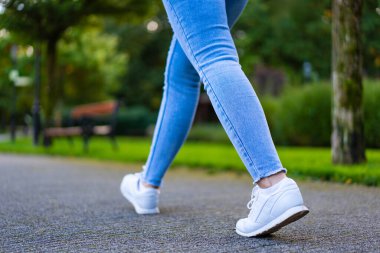
How To Lose Weight With Walking (6 Helpful Guidelines)
How to lose weight with walking? It’s all about making every step count, turning your daily stroll into an effective workout routine. Walking is more than just a simple form of exercise; it’s a powerful tool for weight loss that’s accessible to almost everyone. Imagine a fitness routine that doesn’t require expensive equipment, gym memberships, or intense training sessions—just a comfortable pair of shoes and the great outdoors.
Walking can help shed pounds and improve your mood, boost your metabolism, and transform your overall health. By incorporating brisk walks into your daily routine, you can burn calories, tone your muscles, and reduce stress, all while exploring your neighborhood or enjoying nature. Discover how this low-impact, enjoyable activity can be the key to reaching your weight loss goals and enhancing your well-being.

How To Lose Weight With Walking
Walking is an effective way to lose weight. It is simple, low-impact, and accessible for all fitness levels. By incorporating regular walking into your routine, you can burn calories, improve your metabolism, and boost overall health. For optimal weight loss, aim for consistency, intensity, and variety in your walking regimen.
Benefits of Walking for Weight Loss
Walking helps burn calories, which is essential for losing weight. A brisk walk increases your heart rate, boosting cardiovascular health while engaging your muscles for improved strength and endurance. Regular walking can help manage weight, reduce body fat, and improve mood by releasing endorphins.
Walking also lowers stress levels, enhancing mental well-being and encouraging better lifestyle choices. With its accessibility, walking fits easily into daily routines without requiring special equipment or gym memberships. It’s a sustainable form of exercise that can be adjusted to suit any fitness level, making it a popular choice for those seeking gradual, lasting weight loss.
How to Get Started with a Walking Routine
Begin with short, manageable walks, gradually increasing duration and intensity. Start with 15 to 30 minutes daily, aiming to walk at least 5 days a week. Wear comfortable shoes to support your feet and prevent injuries. Stay hydrated and listen to your body’s signals, adjusting your pace as needed.
For beginners, it’s essential to find a comfortable pace, gradually increasing speed and distance over time. Incorporate walking into your daily life by choosing stairs over elevators, parking farther from entrances, or taking short walk breaks during work. This habit helps integrate physical activity seamlessly into your routine, promoting consistent weight loss efforts.
Techniques to Boost Calorie Burn
Increase calorie burn by incorporating interval training, varying your pace with bursts of fast walking followed by slower recovery periods. Add hills or stairs to your route for additional resistance and engage your core muscles by maintaining good posture.
Swing your arms to enhance momentum and balance. Consider using walking poles to involve your upper body more actively. Interval walking not only burns more calories but also keeps the routine engaging and challenging, preventing boredom. By alternating intensity levels, your body works harder, improving endurance and calorie expenditure.
Setting and Achieving Walking Goals
Set realistic goals to keep motivated and track your progress. Use a pedometer or fitness tracker to monitor steps, aiming for at least 10,000 steps daily. Gradually increase your step count as you build stamina. Celebrate small milestones to stay motivated and maintain consistency. Create a walking schedule that fits your lifestyle, ensuring regular commitment. Achieving incremental goals builds confidence, encouraging sustained effort towards long-term weight loss objectives. Tracking progress provides a sense of accomplishment, reinforcing the positive impact of walking on your health journey.
Incorporating Walking into a Healthy Lifestyle
Combine walking with a balanced diet to maximize weight loss benefits. Focus on nutrient-dense foods, like fruits, vegetables, lean proteins, and whole grains, while reducing processed foods and sugary snacks. Stay hydrated and prioritize sleep for overall wellness. Walking complements healthy eating habits by promoting digestion and regulating appetite. By balancing physical activity with mindful eating, you create a comprehensive approach to weight management. A holistic lifestyle approach ensures sustainable results, enhancing both physical and mental health.
Benefits of Walking for Weight Loss
Calorie Burning
Walking is a highly effective and accessible form of exercise for weight loss, offering numerous benefits due to its calorie-burning potential. When you walk, your body uses energy to move, which results in calorie expenditure. The number of calories burned while walking depends on several factors, including speed, terrain, and body weight. Walking at a brisk pace can significantly increase calorie burn compared to a leisurely stroll, as a faster speed requires more energy.
Additionally, walking on varied terrains, such as uphill paths or uneven surfaces, can enhance the workout’s intensity, leading to greater calorie expenditure. Individuals with higher body weight also tend to burn more calories when walking, as their bodies require more energy to move. Overall, incorporating regular walking into your routine can be an effective and sustainable strategy for weight loss, improving cardiovascular health, and boosting overall fitness.
Low Risk of Injury
Walking is a highly effective and accessible exercise for weight loss that offers numerous benefits with a low risk of injury. Unlike high-impact activities such as running or intense cardio workouts, walking puts minimal stress on the joints, making it an ideal option for people of all ages and fitness levels. It’s a gentle, low-impact form of exercise that can be easily incorporated into daily routine, whether through a leisurely stroll or a brisk walk.
Walking helps burn calories, supports cardiovascular health, and can improve mood through the release of endorphins. When compared to other forms of exercise, walking is particularly advantageous for beginners or those returning to fitness after an injury, as it requires no special equipment and can be done virtually anywhere. Additionally, walking can be easily adapted to fit individual fitness levels by varying speed, distance, and terrain, ensuring it remains challenging and effective for weight loss goals over time.

Mental Health Benefits
Walking is a simple yet highly effective exercise for weight loss, offering numerous physical and mental health benefits. As a low-impact aerobic activity, walking helps burn calories, which can contribute to weight loss and improved body composition when combined with a healthy diet.
Additionally, walking enhances mental well-being by reducing stress and anxiety levels through the release of endorphins, which are natural mood elevators. Regular walks can lead to significant improvements in mood and motivation, fostering a positive outlook and greater resilience to life’s challenges.
The rhythmic nature of walking also provides a meditative effect, allowing individuals to clear their minds and focus on the present moment, further reducing stress and promoting relaxation. Whether it’s a brisk morning walk or a leisurely evening stroll, incorporating walking into your daily routine can significantly enhance both physical health and mental well-being.
Planning Your Walking Routine
Assessing Your Current Fitness Level
Planning a walking routine starts with assessing your current fitness level to ensure your plan is safe and effective. Begin by evaluating your starting point: consider factors such as how often you currently walk, your average walking speed, and how far you can comfortably go without feeling overly fatigued. This self-assessment helps you understand your baseline fitness and tailor your routine to match your capabilities.
Once you have a clear idea of where you are starting, set achievable milestones that will guide your progress. These milestones might include increasing your walking distance by a certain amount each week or gradually picking up the pace. Setting realistic goals will not only help you track your improvements but also keep you motivated and committed to your walking routine. Remember, the key is to progress at a pace that challenges you without causing injury or burnout.

Creating a Walking Schedule
Establishing a walking routine is an excellent way to enhance physical health and mental well-being. Start by creating a walking schedule that fits seamlessly into your daily life. Aim to walk at least three to five times a week, gradually increasing the duration and intensity as your fitness improves. For beginners, start with 10-15 minute walks and progressively work up to 30-60 minutes per session.
To ensure you continue to challenge yourself, gradually increase the intensity by incorporating brisk walking, hills, or intervals as you build stamina. It’s important to listen to your body and adjust your pace accordingly, ensuring that your routine remains enjoyable and sustainable. Remember to wear comfortable shoes and stay hydrated to maximize the benefits of your walking routine.
Choosing the Right Gear
Planning a walking routine involves several key considerations to ensure you get the most out of your exercise while staying comfortable and safe. Begin by setting clear goals, such as the distance or time you want to walk each day, and gradually increase these as your fitness improves. It’s helpful to choose a variety of routes to keep your walks interesting and challenging. Selecting the right gear is crucial, particularly when it comes to footwear. Supportive shoes with good arch support and cushioning can prevent injuries and enhance your walking experience by reducing strain on your feet, knees, and hips.
Additionally, wearing weather-appropriate clothing will keep you comfortable in different conditions. In warmer weather, opt for lightweight, breathable fabrics that wick moisture away, while in cooler climates, layering is key to maintaining warmth without overheating. Don’t forget accessories like hats, sunglasses, and sunscreen for sun protection, and gloves or a hat for warmth in colder months. With thoughtful planning and the right gear, your walking routine can be both enjoyable and effective.
Techniques to Enhance Weight Loss
Increasing Intensity
Walking is an effective and accessible exercise for weight loss, and several techniques can enhance its effectiveness. Increasing the intensity of your walks is one way to burn more calories and improve cardiovascular fitness. This can be achieved by incorporating intervals or speed walking, where you alternate between periods of brisk walking and a slower pace. This not only increases your heart rate but also boosts metabolism.
Another technique is adding inclines or stair walking, which engages different muscle groups and increases the effort required, thereby burning more calories. Walking uphill or on a treadmill with an incline challenges your body and can improve muscle tone and endurance. Additionally, incorporating these variations keeps your routine dynamic and can prevent plateaus in your weight loss journey.
Incorporating Strength Training
Walking is a fantastic form of exercise for weight loss, and its effectiveness can be enhanced by incorporating strength training. Adding simple bodyweight exercises like squats, lunges, and push-ups to your walking routine can help build muscle and increase calorie burn.
Strength training boosts metabolism by increasing muscle mass, which in turn raises your resting metabolic rate—meaning you burn more calories even at rest. Alternating between walking and bodyweight exercise during a workout session can keep your heart rate elevated, maximize fat loss, and improve overall fitness. Additionally, building muscle helps improve bone density, joint health, and overall body composition, making it a valuable complement to any walking routine aimed at weight loss.

Monitoring Progress
Enhancing weight loss through walking involves employing several effective techniques that can maximize results. One key strategy is monitoring progress, which allows individuals to stay motivated and adjust their routines as needed. Tracking steps with pedometers or smartphone apps provides real-time feedback, helping walkers understand their activity levels and identify patterns.
Setting and achieving daily step goals is another crucial component; these goals should be realistic and gradually increased as fitness improves. By aiming for a specific number of steps each day, individuals can create a structured routine that ensures consistent activity. Additionally, incorporating interval walking, where bursts of faster walking are alternated with slower-paced walking, can boost calorie burn and improve cardiovascular fitness. By combining these strategies, walking becomes an effective and sustainable method for weight loss.
Nutritional Considerations
Balanced Diet for Weight Loss
Walking is a fantastic way to promote weight loss, and when paired with the right nutritional considerations, it can be even more effective. A balanced diet is crucial for weight loss, providing the body with the necessary nutrients to support energy levels and overall health. Emphasizing nutrient-dense foods, such as fruits, vegetables, lean proteins, and whole grains, ensures that the body receives essential vitamins and minerals without excessive calories.
Incorporating portion control and mindful eating can further enhance weight loss efforts. By being attentive to hunger cues and savoring each bite, individuals can prevent overeating and develop a healthier relationship with food. This approach not only aids in shedding pounds but also promotes long-term wellness and vitality, complementing the benefits of regular walking.
Hydration
When aiming for weight loss through walking, proper hydration is crucial for optimizing metabolic function and overall performance. Water plays a key role in metabolism by aiding in the digestion and absorption of nutrients, as well as helping to regulate body temperature and remove waste products. To stay hydrated, it’s important to drink water consistently throughout the day, not just when you’re thirsty.
A general guideline is to consume at least 8 cups (64 ounces) of water daily, though individual needs may vary based on factors like activity level and climate. Additionally, incorporating hydrating foods such as fruits and vegetables into your diet can further support your hydration efforts. Carrying a reusable water bottle and setting reminders can also help ensure you maintain adequate hydration throughout your walking routine.
Managing Cravings and Snacking
When embarking on a weight loss journey with walking, nutrition plays a crucial role in achieving your goals. Managing cravings and snacking effectively can help maintain progress and support overall health. Opt for healthy snacks such as fresh fruits, vegetables with hummus, or a handful of nuts, which provide essential nutrients without excessive calories.
Understanding your hunger cues is also important; differentiate between genuine hunger and emotional or habitual eating. Eating mindfully and listening to your body’s signals can prevent overeating and help you stay on track. By combining nutritious snacks with regular walking, you can create a balanced approach to weight loss that supports both physical and mental well-being.
Staying Motivated
Finding a Walking Partner or Group
Staying motivated to walk regularly can be greatly enhanced by finding a walking partner or joining a walking group. The social benefits of walking with others are significant, as it provides a sense of camaraderie and shared goals, which can make the activity more enjoyable and less of a chore. Having a walking partner or being part of a group also introduces a layer of accountability; knowing that others are counting on you to show up can be a powerful incentive to stick to your walking routine. Additionally, the opportunity to socialize and share experiences while walking can boost your overall mood and reinforce your commitment to staying active.
Setting Short-term and Long-term Goals
Staying motivated in your fitness journey involves a mix of strategic planning and personal celebration. Start by setting clear short-term and long-term goals that align with your overall health objectives. Short-term goals, such as completing a specific workout or reaching a certain number of exercise sessions each week, provide immediate milestones and a sense of accomplishment.
Long-term goals, like achieving a particular fitness level or mastering a new skill, offer a broader vision for your progress. Celebrating these milestones, no matter how small, reinforces your commitment and boosts your morale. As your fitness improves, it’s crucial to adjust your goals to continue challenging yourself and prevent stagnation. By regularly revisiting and refining your objectives, you keep your motivation high and stay on track with your evolving fitness journey.
Overcoming Plateaus
Staying motivated during a weight loss journey, especially when encountering plateaus, requires a blend of persistence and strategic adjustments. Overcoming these stalls often involves reassessing and tweaking your approach to ensure continued progress.
One effective strategy is to introduce variety into your workout; this not only helps to prevent boredom but also challenges different muscle groups and boosts overall fitness. By incorporating diverse exercises and varying the intensity, you can reignite your enthusiasm and keep your body from adapting too quickly, which can help break through plateaus and maintain momentum in your weight loss efforts.
Safety and Precautions
Listening to Your Body
When incorporating walking into a weight loss regimen, safety and precautions are crucial for maximizing benefits while avoiding injury. Listening to your body is essential—pay attention to any discomfort or unusual fatigue that might indicate overexertion.
Common signs include excessive soreness, dizziness, or shortness of breath. If you experience these symptoms, it’s important to take a step back and allow for adequate rest and recovery. Incorporating rest days into your routine helps prevent overuse injuries and supports overall progress. Balancing your walking routine with proper hydration, appropriate footwear, and gradual increases in intensity will ensure a safe and effective weight loss journey.
Environmental Awareness
When embarking on a weight loss journey that includes walking as a key component, it’s crucial to prioritize safety and take necessary precautions. First, being environmentally aware involves understanding and adapting to the conditions of your walking route. Opt for well-maintained paths and avoid areas prone to hazards such as uneven terrain or heavy traffic.
Choosing safe walking routes enhances your security and comfort. Additionally, staying visible in low-light conditions is essential; wear reflective clothing or gear and carry a flashlight to ensure that you are easily seen by others. These steps help prevent accidents and create a safer, more effective walking routine.
Frequently Asked Questions (FAQ) about How To Lose Weight With Walking
Q1. How effective is walking for weight loss?
A. Walking is an effective and accessible way to lose weight, especially when done consistently. It helps burn calories, increases metabolism, and improves cardiovascular health. The key is to walk regularly and combine it with a healthy diet to see noticeable results.
Q2. How much should I walk daily to lose weight?
A. For weight loss, aim to walk at least 30 to 60 minutes most days of the week. This equates to about 150 to 300 minutes per week. Increasing the intensity or duration of your walks can lead to more significant weight loss.
Q3. Can walking alone help me lose belly fat?
A. Walking can contribute to overall fat loss, including belly fat. While it’s not possible to target specific areas for fat loss, walking helps reduce overall body fat, which can eventually lead to a slimmer waistline.
Q4. Is brisk walking more effective than regular walking?
A. Yes, brisk walking is more effective for weight loss than a leisurely pace. Walking briskly elevates your heart rate, leading to higher calorie expenditure. Aim for a pace where you can still hold a conversation but are breathing harder than usual.
Q5. How can I make my walking routine more challenging?
A. To make walking more challenging, try incorporating interval walking (alternating between fast and slow paces), walking uphill, or adding weights like a weighted vest or ankle weights. These variations can increase calorie burn and improve muscle tone.
Q6. Can I listen to music or podcasts while walking to lose weight?
A. Absolutely! Listening to music or podcasts can make your walks more enjoyable and help you stay motivated. Creating a playlist with upbeat songs can also help you maintain a brisk pace.
Q7. Should I walk indoors or outdoors for weight loss?
A. Both indoor and outdoor walking can be effective for weight loss. Walking outdoors offers fresh air and a change of scenery, which can be motivating, while indoor walking on a treadmill allows for controlled conditions regardless of weather. Choose the option that you enjoy and can maintain consistently.
Q8. How important is diet when walking to lose weight?
A. Diet plays a crucial role in weight loss. While walking burns calories, creating a calorie deficit through healthy eating is essential for losing weight. Focus on consuming whole foods, reducing portion sizes, and avoiding processed foods to complement your walking routine.
Q9. What should I wear for walking to lose weight?
A. Wear comfortable clothing that allows for a full range of motion. Opt for breathable fabrics to help regulate body temperature. Invest in a good pair of walking shoes that provide support and cushioning to prevent injuries.
Q10. How soon can I expect to see weight loss results from walking?
A. Weight loss results can vary depending on factors like starting weight, walking intensity, and dietary habits. Typically, you may start noticing changes in 4 to 6 weeks with consistent walking and a healthy diet. Remember, gradual weight loss is more sustainable and healthier.
Conclusion
In conclusion, walking is a highly effective and accessible way to lose weight, offering numerous health benefits beyond weight management. By incorporating regular walking sessions into your routine, you can burn calories, improve cardiovascular health, and enhance overall well-being. To maximize weight loss, aim for a consistent walking schedule, gradually increasing the duration and intensity of your walks.
Combining walking with a balanced diet and healthy lifestyle choices can lead to sustainable weight loss and improved fitness. Remember to stay hydrated, wear comfortable shoes, and maintain proper posture to avoid injury. With dedication and perseverance, walking can be a simple yet powerful tool in achieving and maintaining a healthy weight.